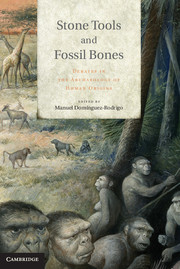
-
Select format
-
- Publisher:
- Cambridge University Press
- Publication date:
- 05 April 2012
- 26 March 2012
- ISBN:
- 9781139149327
- 9781107022928
- Dimensions:
- (228 x 152 mm)
- Weight & Pages:
- 0.63kg, 376 Pages
- Dimensions:
- Weight & Pages:
- Subjects:
- Prehistory, Archaeology, Archaeological Science
You may already have access via personal or institutional login- Subjects:
- Prehistory, Archaeology, Archaeological Science
Book description
The stone tools and fossil bones from the earliest archaeological sites in Africa have been used over the past fifty years to create models that interpret how early hominins lived, foraged, behaved and communicated and how early and modern humans evolved. In this book, an international team of archaeologists and primatologists examines early Stone Age tools and bones and uses scientific methods to test alternative hypotheses that explain the archaeological record. By focusing on both lithics and faunal records, this volume presents the most holistic view to date of the archaeology of human origins.
Reviews
'This volume has a good feel to it - a handsome compact book about the early archaeology of human evolution, all in one … This collection is stimulating in reflecting a strong hand, but also showing a plurality of contributions and opinions.'
John Gowlett Source: Journal of African Archaeology
Contents
Metrics
Altmetric attention score
Full text views
Full text views help Loading metrics...
Loading metrics...
* Views captured on Cambridge Core between #date#. This data will be updated every 24 hours.
Usage data cannot currently be displayed.
Accessibility standard: Unknown
Why this information is here
This section outlines the accessibility features of this content - including support for screen readers, full keyboard navigation and high-contrast display options. This may not be relevant for you.
Accessibility Information
Accessibility compliance for the PDF of this book is currently unknown and may be updated in the future.


